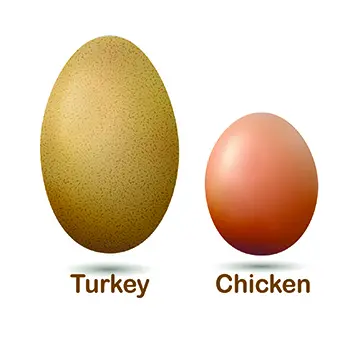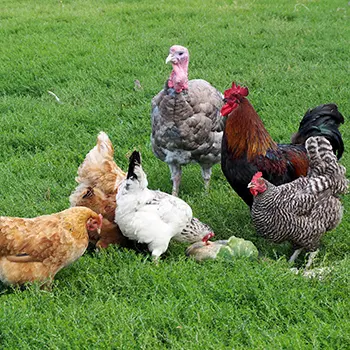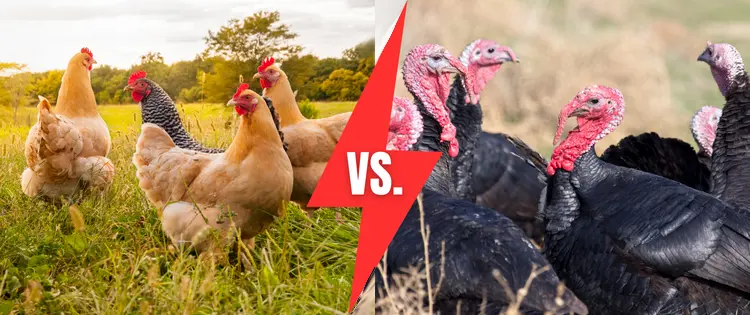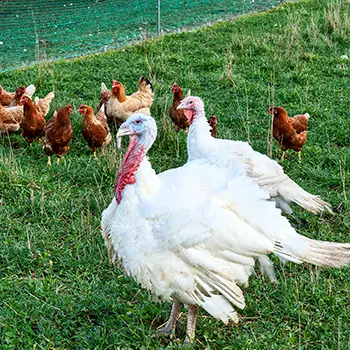When trying to decide on what your first poultry will be, you’ll find yourself in a bit of a pickle. In fact, there are so many choices that you’ll probably end up with several types of poultry down the road. Most homesteads do.
Today, I’ll be directly comparing chickens versus turkeys in terms of their contribution to the homestead and how you can better decide between these two species. Let’s take a look.
Egg Laying: Value vs Volume
Perhaps one of the first things we consider when gaining interest in a poultry species is its egg-laying capabilities. Indeed, we’ve harnessed poultry overall to provide nutritious eggs for us every morning for breakfast. Chickens are adept at laying eggs.
Turkeys? Well, that all depends on the type. Standard/heritage breeds will lay seasonally. This means that they lay for a period of 1-3 months out of the calendar year and then get broody for a bit. They may lay a second “clutch” (group) of eggs for 1-3 months after a month or two of being broody, but this varies depending on the amount of light and warmth your area gets. If you live up north, it’s likely that you’ll only get 1 laying season and 1 broody season before the leaves are changing color and the birds are settling into molt and rest up for the next season.
Broad-breasted varieties of turkeys cannot mate naturally and therefore are useless as egg-laying birds for the homestead. They can make nice crafting eggs because they’re stylish, but keeping a laying hen turkey beyond her natural harvest date is likely going to be very rough on her physiologically and may result in the need to suddenly euthanize due to poor health. Bluntly, broad-breasted varieties are best left to the professionals.
Chickens, all except meat birds, are going to lay from March or April until September or October, regularly. What is “regularly”? It depends on the breed, but you can bet on usually 3-5 eggs per 1-2-year-old hen every week. Some lay every day. Chickens win this category for volume, but the rarer turkey eggs are usually worth more if a bit more difficult to sell (there is a smaller market).
Feather Sales
Whether you pluck your birds once you harvest them for meat (we’ll get to that in a minute) or you are simply picking up shed feathers, most turkey feathers sell higher to craftspeople than chicken feathers; with the exception of VERY colorful/highly marked chicken feathers. Turkeys win this one.
Meat Value
A meat turkey (broad-breasted) vs a meat chicken is a very evenly matched set. Overall, you will get more meat from chickens in less time for less feed, but the value isn’t there. Meat turkeys are worth every penny. Heritage breeds of both species tend to sell a lot higher, too, for meat purposes. Many people raise barred rock or Rhode Island Red chickens, keep them in the egg pen for a couple of years, then sell the girls off as stewing hens in their second winter and replace them with chicks to over winter so they’ll start laying as soon as the snow thaws. There isn’t quite as much meat on a heritage bird, turkey, or chicken, but your potential customers are paying for better, healthier meat than the cornish cross chicken they buy in the bag at the store.
Ultimately, if you’re able to let your turkeys pasture-raise themselves and are willing to raise a heritage breed (or if broad-breasted are very popular in your area), I’ll let the turkeys have this one. But it is a very small gap and it feels like you could simply say this is a tie.
Feed and Raising Time
We’ll break this up into four mini sections. Meat turkeys, meat chickens, heritage (egg and meat) chickens, and heritage (egg and meat) turkeys.
Meat turkeys (broad-breasted) take approximately 16-20 weeks to reach butcher size. This depends a little on what feed you’re using and their ability to run around and enjoy themselves, but most simply want to settle next to the feeder and enjoy themselves there, instead.
Meat chickens (primarily cornish cross, but not always!) take around 8-10 weeks to reach butcher size. Some may be ready as early as six weeks, and others may be ready as late as 16 weeks but take note that the latter ones often have wooden breast meat and other problems.
Heritage chickens will begin laying near weeks 16 to 20 depending on the weather. Many farmers start eggs as soon as they can in November (usually with a near Thanksgiving hatch date) so their winter chicks will be ready to lay when the spring comes, or very close to it. Some specialty varieties of heritage chickens (usually considered “ornamental”) may wait until 25 weeks, but this is pretty rare. If you want to eat these birds, you’ll want to wait until they’re a year old or so.
Heritage turkeys begin laying around 24-32 weeks old, depending on the seasons. Those born in the spring will not lay until the following spring in most cases. The best time to get turkey poults (young turkeys are called poults, not chicks) is in late summer or early fall. You may also butcher heritage turkeys at 24-32 weeks old, but many allow them to produce eggs for a year or two to replenish their flocks.
Circumstances
The circumstances of your land have a great deal to do with what poultry you should get. Is it marshy? Pond-y? You need to look at ducks more than either of this potential poultry. Is it arid and mostly just brush and weeds? Chickens will love it. Turkeys prefer woods, dense brush, and heavily overgrown pastures.
You’ll also need to get your property checked for a disease called a blackhead. This is only specific to turkeys but kills young poults very quickly and there’s little you can do to stop it. If you have blackheads on your property, get chickens. They’re immune to it.
Round-Up
Ultimately, we believe that both chickens and turkeys are wonderful first-time poultry for beginning homesteaders. If the chicken difficulty is a level 1, perhaps turkeys are a level 1.5 or 1.25, but they are very close and comparable.
In the end, you should choose what is best for your property and what your local area doesn’t have a lot of. If everyone is raising chickens, find out why! Perhaps you should be the newcomer who invests in turkeys. And if there is a good reason no one raises turkeys (such as blackheads being a constant issue), raise chickens instead.
Whatever you decide, we wish you happy poultry raising! Questions? Comments? Talk to us down below!
You may also like:
Most Vicious Chicken Predators
What Happens When You Keep Your Meat in Salt For 1 Month (Video)
Why You Should Raise Ducks Instead Of Chickens
Livestock Animals You Should Start Raising For The Upcoming Economic Crisis










